Bruno Génésio’s approach at LOSC Lille brings a fresh perspective to their tactical identity, merging fluidity with a structured game plan. Known for his strategic versatility, Génésio emphasizes control through possession while remaining flexible enough to adapt to the dynamics of each match. His tactics highlight a balanced approach, combining disciplined defending with quick transitions and proactive play in the final third.
This tactical analysis breaks down Génésio’s key principles at Lille, from his formations to his pressing style, and examines how he uses player roles and movement to create a cohesive, adaptable team capable of challenging top-tier opponents.
Build-up
Low Build-up
Bruno Génésio sets his team up in a 1-4-2-2-2 formation in the low build-up. He uses two dropping strikers/number-tens and looks to attract opposition players to open up the space in behind for the wingers to exploit.
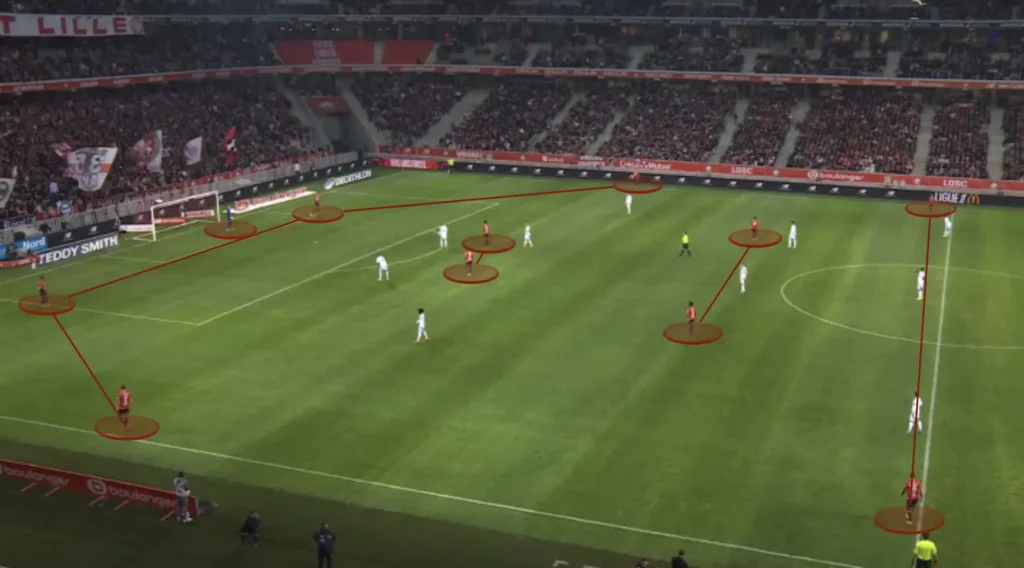
This structure, with two dropping strikers and two high wingers, popularized by Roberto De Zerbi, questions the opposition center-backs, forcing them to make difficult decisions. If they push up on the dropping strikers, the space behind them opens up, giving Lille’s wingers space to run into. However, if they stay back, Lille will have numerical superiority in the midfield, allowing them to play through the press.
Génésio mainly wants to beat the press by finding a dropping striker in the space between the opposition’s defense and midfield, who can bounce the ball to a holding midfielder, who then can progress the ball forward.
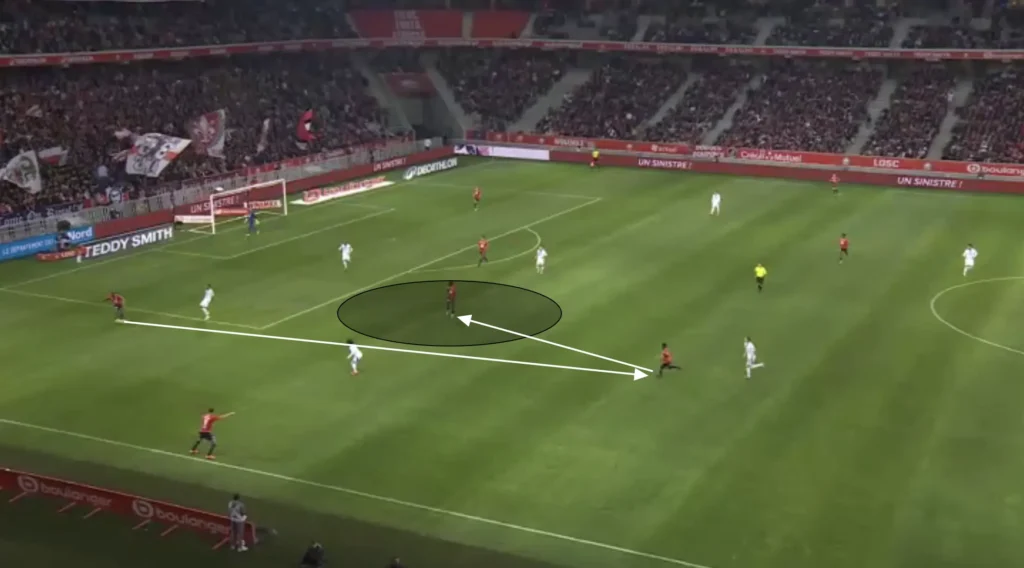
Additionally, the dropping striker can often turn when receiving the ball. Lille’s winger will move up when the striker drops, which pins the opposition defenders. When the defenders stay back to control the winger, the striker will be completely open in the space between the opposition’s defense and midfield, allowing him to turn and progress the ball forward when receiving a pass from the backline.
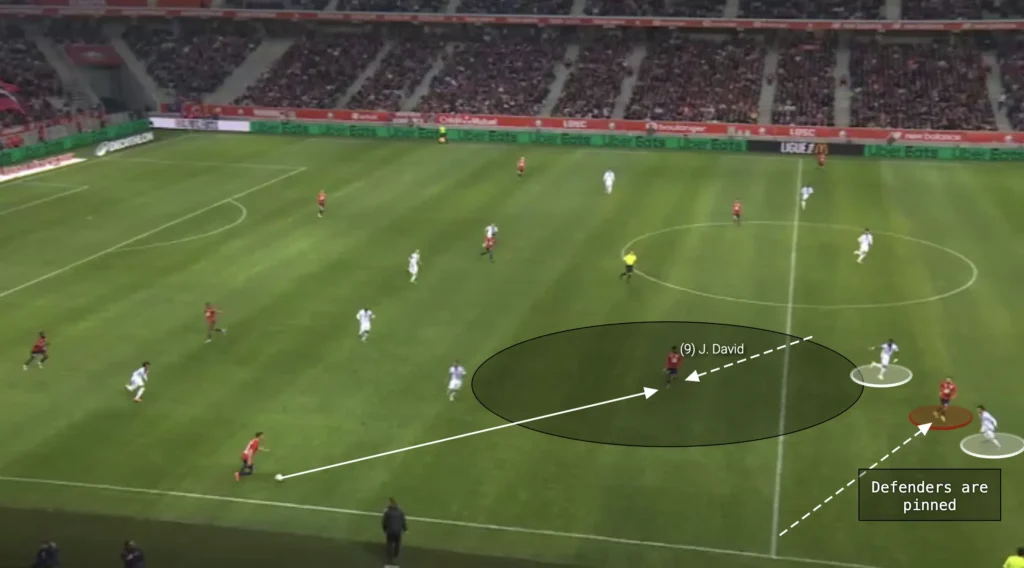
When Lille beat the press, the attackers will immediately make runs in behind, looking to exploit the space behind the opposition’s backline.
Lille are also not afraid to be more direct in the low build-up. If the opposition comes up and presses man-to-man, there will be numerical equality up top with Lille’s attackers against the opposition defenders. The goalkeeper will sometimes find an early longer ball up to the attackers, aiming to win 4v4 or 3v3 situations. The Lille attackers have good individual quality and will often win these battles to create goalscoring
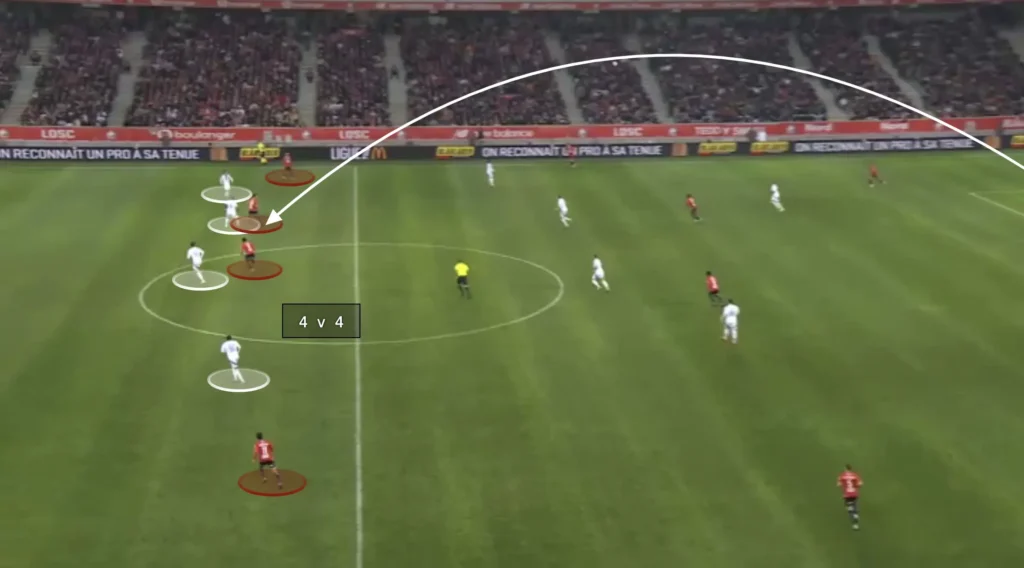
High Build-up
In the high build-up, Génésio’s Lille usually use a very fluid 1-4-3-3 formation, with a back four, one number-six, two number-eights, and a front three.
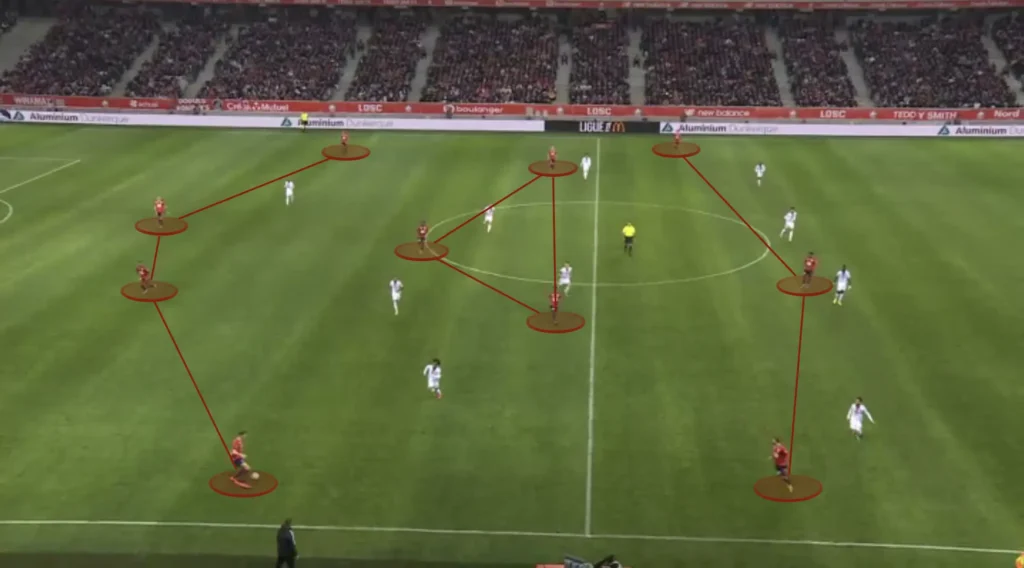
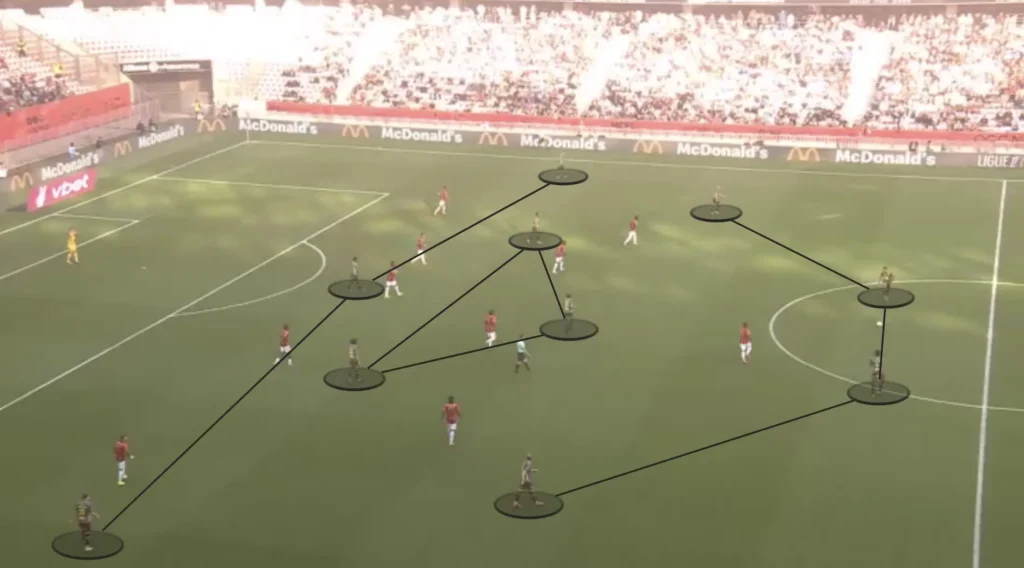
Building up in a 1-4-3-3 formation focuses on creating a solid foundation at the back while maintaining fluidity and options in the midfield. The formation begins with four defenders, who provide width and stability, allowing for controlled possession from deep areas. The single defensive midfielder connects the defense to the midfield, dictating the tempo and distributing the ball to the two more advanced central midfielders. These midfielders position themselves to exploit spaces between the opposition’s lines, creating passing triangles that facilitate smooth progression up the pitch. The three forwards, with the central striker as the focal point, are always ready to receive the ball, either through direct passes or by making runs behind the defense. This setup allows the team to transition quickly from attack to defense, maintaining pressure on the opponent while ensuring defensive coverage.
Additionally, in Lille’s attacking system, the fullbacks usually tuck inside into central midfield areas instead of staying wide and hugging the touchline.
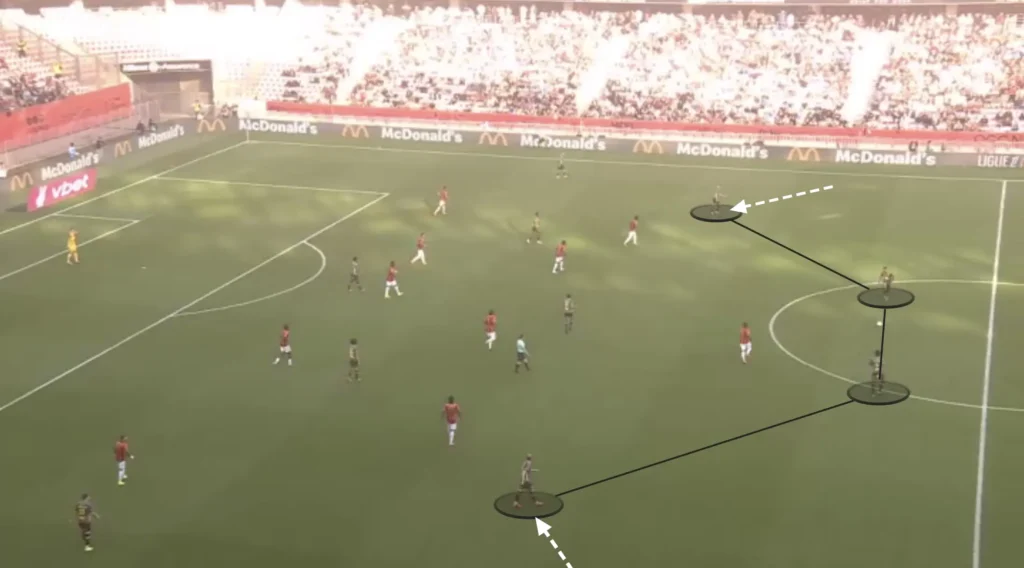
This allows them to contribute to the build-up, create numerical advantages in the middle, and dictate play with their passing range.
Rotations and Fluidity
The Lille players constantly rotate during the build-up. The team adopts a dynamic approach, shifting between formations to create numerical advantages and exploit spaces. Génésio’s focus is always to get the players into their best positions, where they can make the most out of their individual skills. He emphasizes versatility, with players interchanging positions seamlessly to maintain possession and disrupt the opposition’s defensive structure. This flexibility creates numerical superiorities in different areas, allowing Lille to bypass the opposition’s press while maintaining control.
Lille will, for example, often rotate into a 1-3-2-5 formation during the build-up.
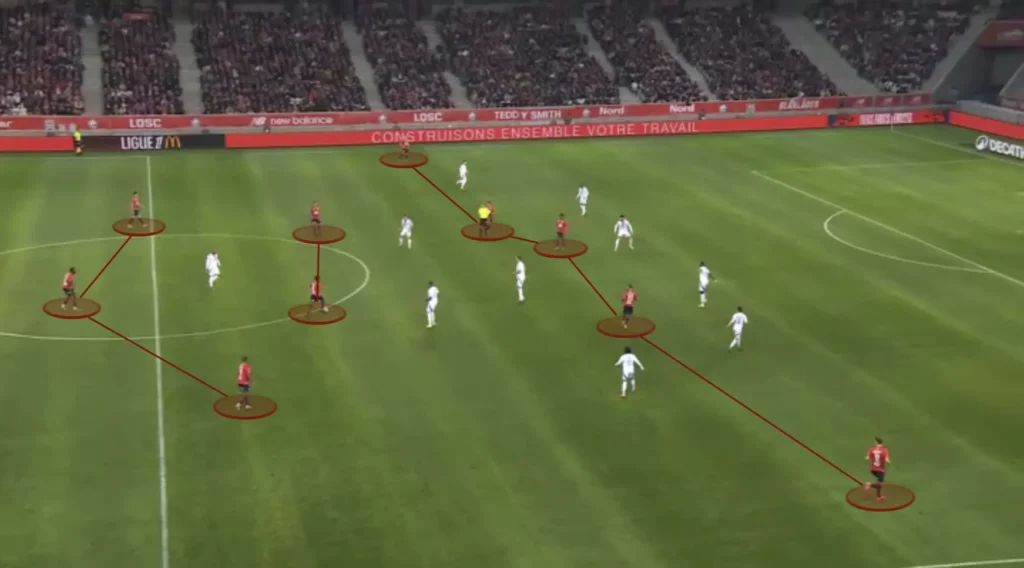
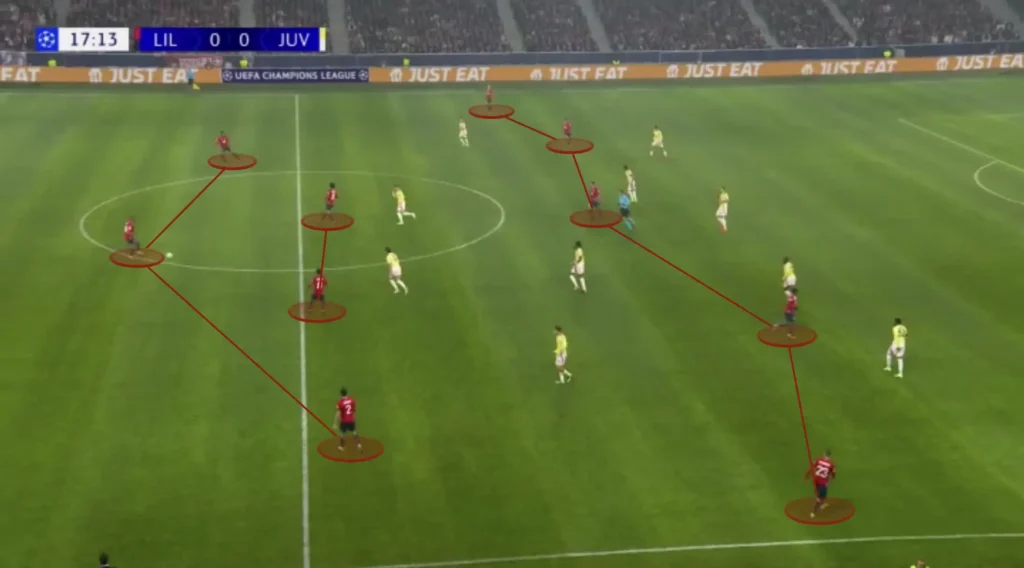
This rotation gives Lille more players higher up the pitch and can help break down teams who defend deep in a low-block.
Numerical Advantages in the Middle
Regardless of the structure, Lille will have many players in the center. Génésio usually has a winger wide on each side and positions the remaining eight players in the middle.
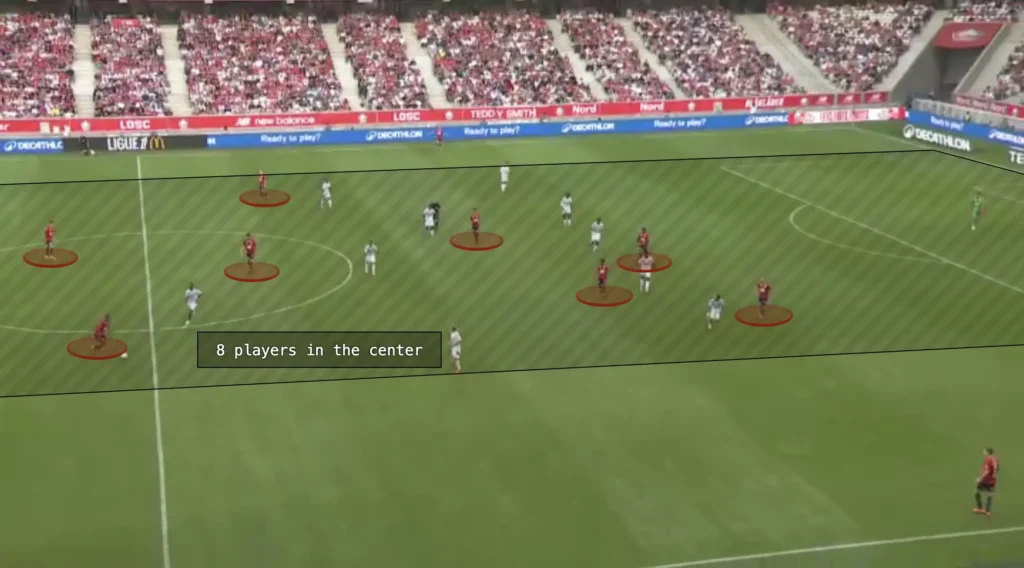
Having only two players out wide and the rest in the middle creates more options in the center and less space between the players. Génésio likes this because he prioritizes playing through the middle. He needs one player out wide to pull the opposition apart while the rest create numerical advantages in the midfield areas.
When a team outnumbers the opposition in the midfield, it can more easily retain the ball, exploit spaces, and progress the ball through the center. Lille will often progress the ball through quick central passes between the midfielders, beating the opposition’s press and exploiting gaps in the defense.
Another purpose for keeping many players in the middle is to shorten the distance between them. This shortens the length of the passes, which naturally shortens the time between passes. This means the opposition players will have less time to push up and press, giving the Lille players more time and control.
Rest-Defence
Génésio also wants many players close to the center to create a good rest-defence structure. Rest-defence in football refers to a team’s defensive organization and structure when they have possession of the ball, specifically aimed at being prepared to defend immediately if they lose it. A good rest-defence structure is crucial for maintaining balance and preventing counterattacks when the team is in possession.
Having many players in the middle and close to the ball gives Lille a good rest-defence, since it allows more players to counterpress when they lose the ball. When losing possession, the four or five Lille players closest will immediately jump on the opposition player with the ball and close the distance to cut off any passing lanes. This approach disrupts the opponent’s transition from defense to attack, forcing errors and creating opportunities to regain control of the ball.
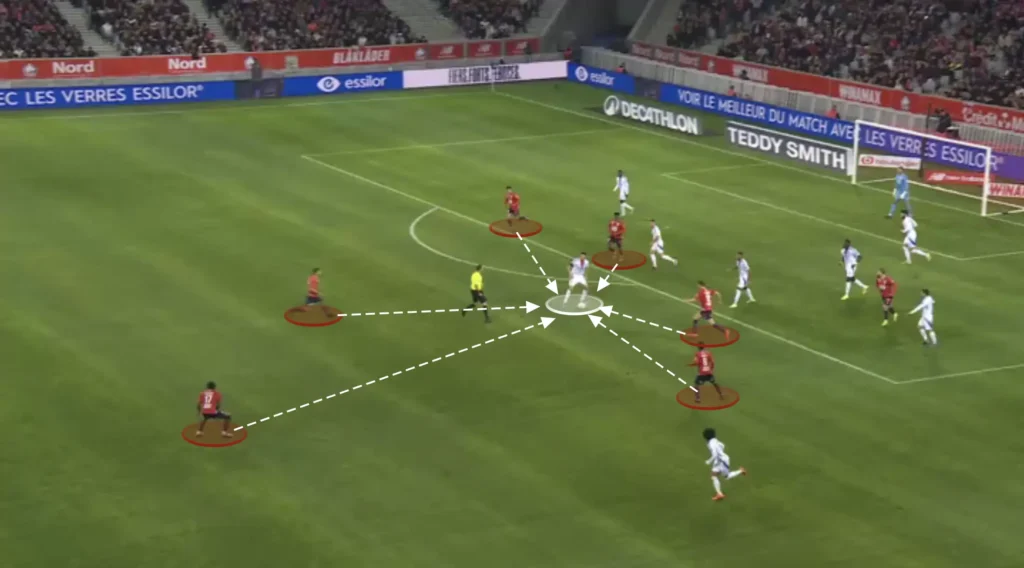
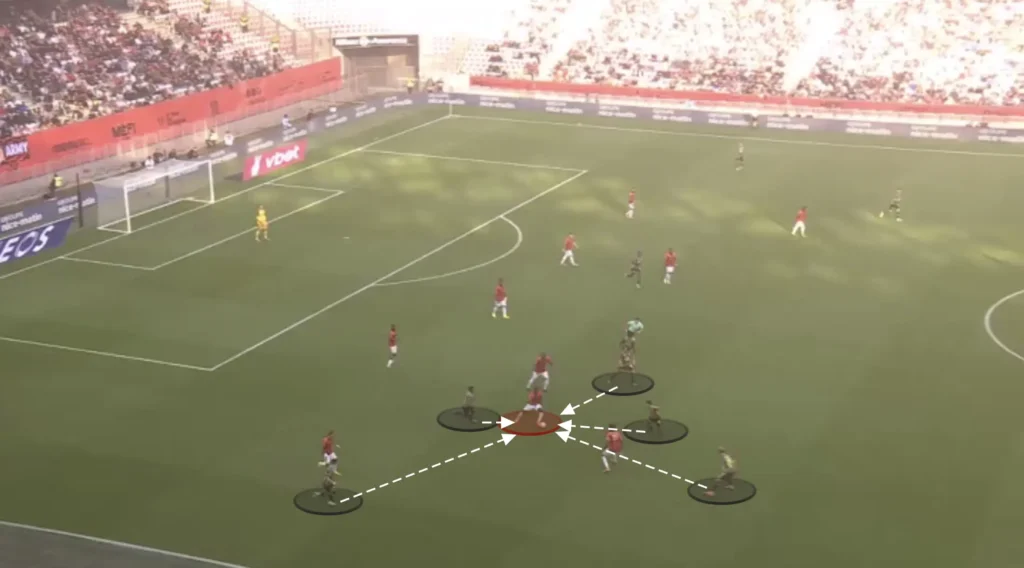
Counterpressing like this keeps Lille on the front foot, allowing them to dominate possession and create more scoring opportunities. However, it requires exceptional fitness, tactical discipline, and teamwork.
High Backline
A massive aspect of Lille’s high build-up is to have the defenders high up and close to the center. This helps in the counterpress because they get closer to the midfield. Having more players close to the center who can win the ball back makes it difficult for the opposition to do anything when they win possession. Furthermore, the high backline shortens the distance between players, shortening the time and length of the passes and preventing the opposition from pushing up their defense.
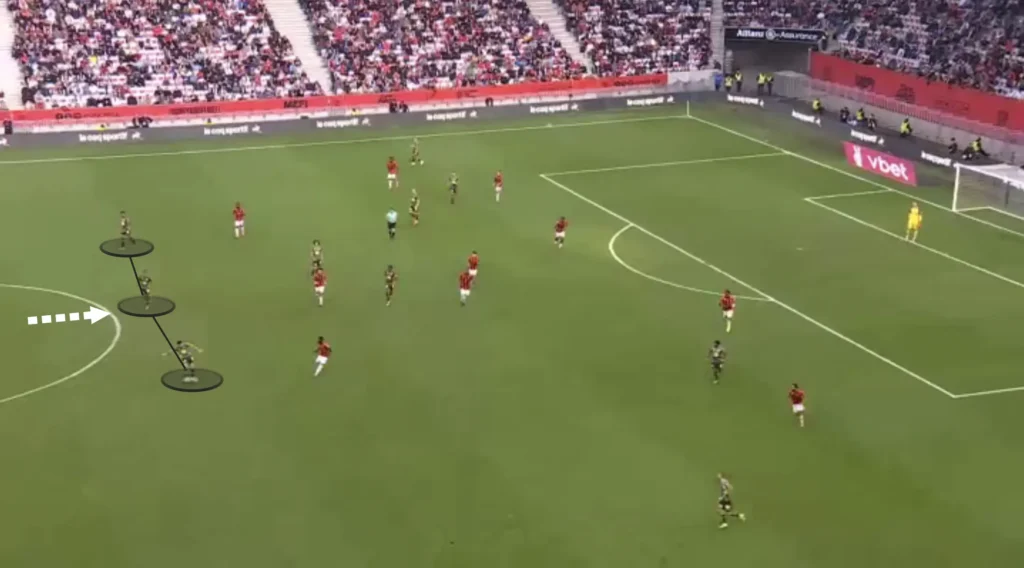
Third-man
Bruno Génésio wants his team to play through the opposition when possible. One vital tool that they often use is the third-man principle. The third-man principle is a tactical concept used to create and exploit space by involving a third player in a passing sequence.
It typically works by having Player A pass the ball to Player B, who then quickly relays it to the free Player C. An opponent will block the pass from Player A to Player C, but the pass from Player B to Player C will be open, which is why he is needed in this passing combination.
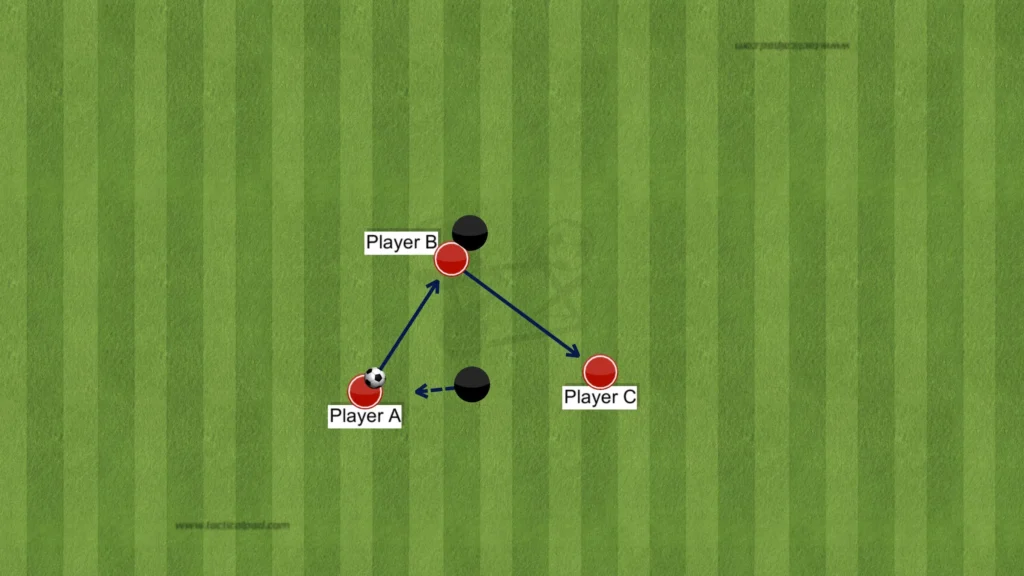
This movement often bypasses an opponent’s pressing line and opens up space, allowing the team to advance the ball more effectively. The key to the third-man principle is timing and positioning, as the third player must anticipate the play, position themselves advantageously, and receive the ball in a manner that breaks the opposition’s defensive structure. This principle is integral to many modern football strategies, promoting fluidity, quick decision-making, and dynamic attacking play.
Lille will, for example, use third-man combinations to find an open center-back when the opposition striker presses the goalkeeper.
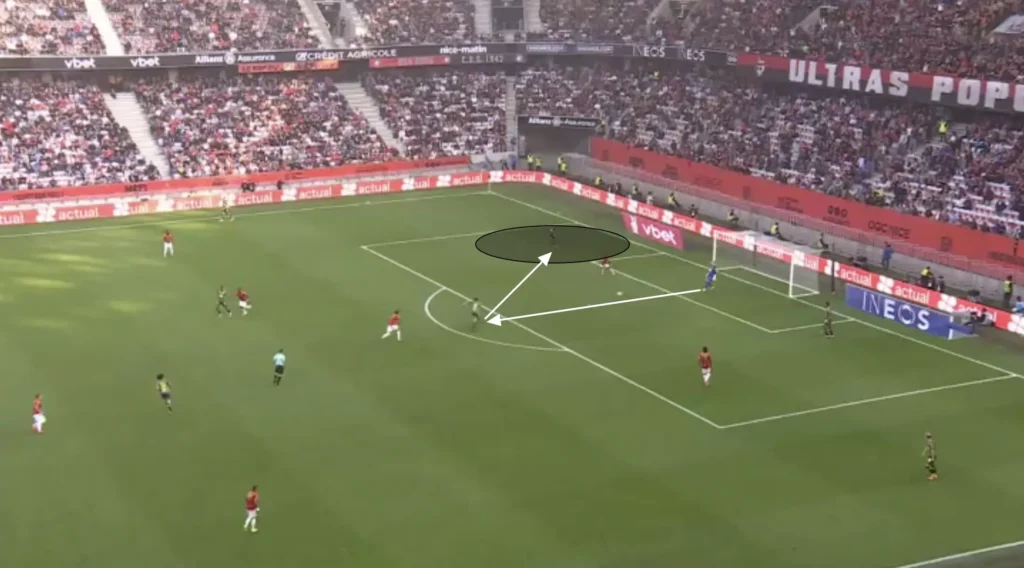
They also use third-man combinations involving the attackers to find open midfielders in spaces between the opposition lines.
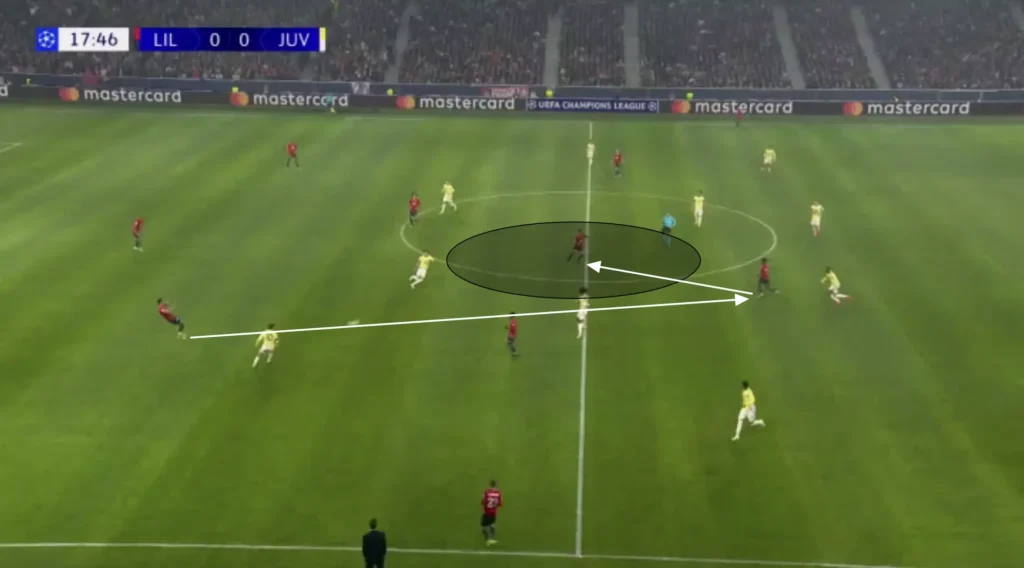
Attacking the Half-Space
In the final third, Génésio’s players usually look to create chances by attacking the space between the opposition center-back and fullback. They primarily do this from the wide areas with underlaps from the midfielders. When the Lille winger receives the ball out wide, he will attract the opposition fullback. This opens the space between the opposition fullback and center-back, which allows a Lille midfielder to make the underlapping run into this space. The ball can be played to the underlapping player, who can cross the ball into the box or attack his defender in a 1v1 situation.
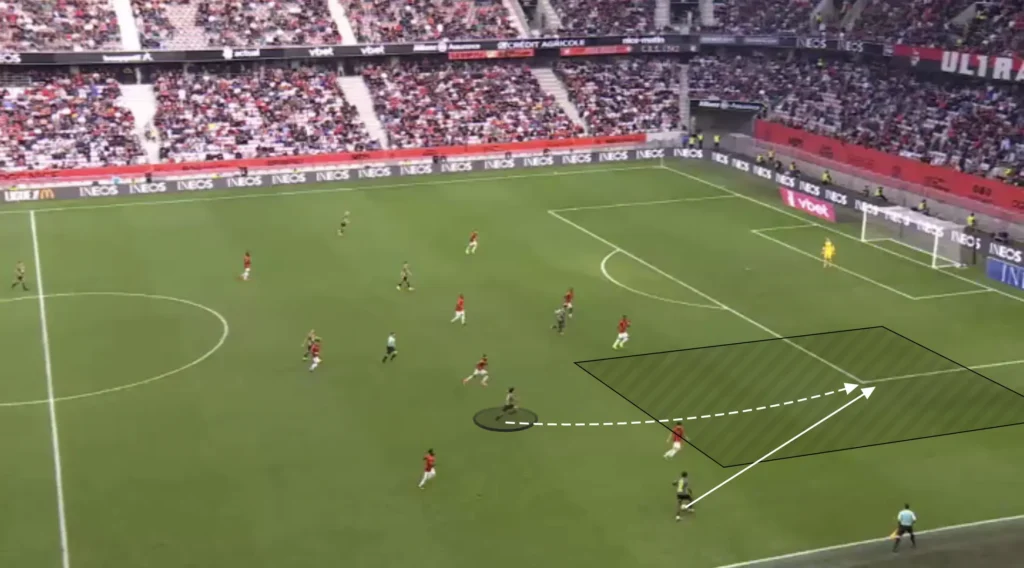
Additionally, the winger does not have to play the ball to the underlapping player. The run from the Lille midfielder will often drag away an opposition defensive midfielder, which opens the space inside. The winger can take the ball inside and shoot or find a pass to a free player in front of the backline.
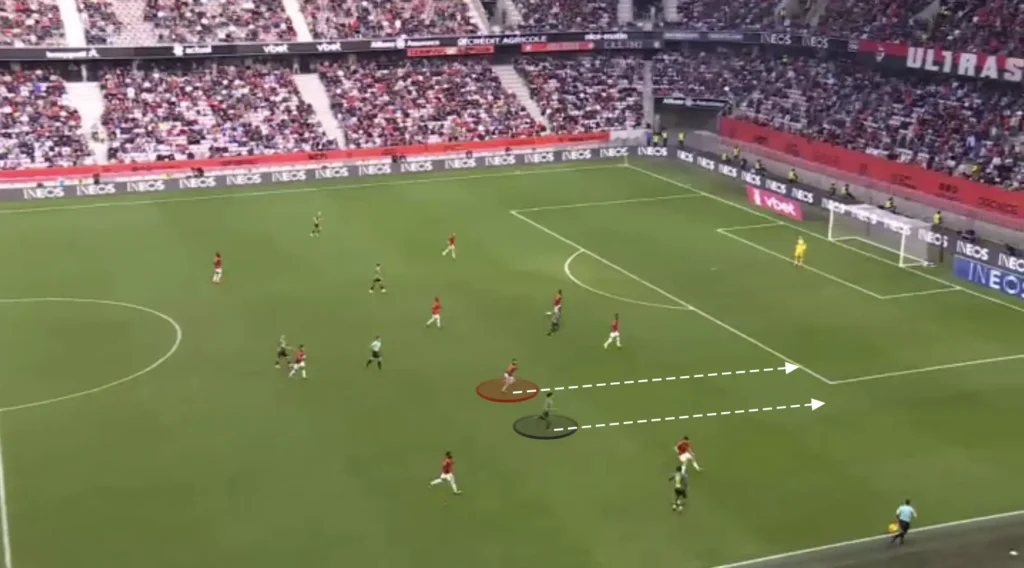
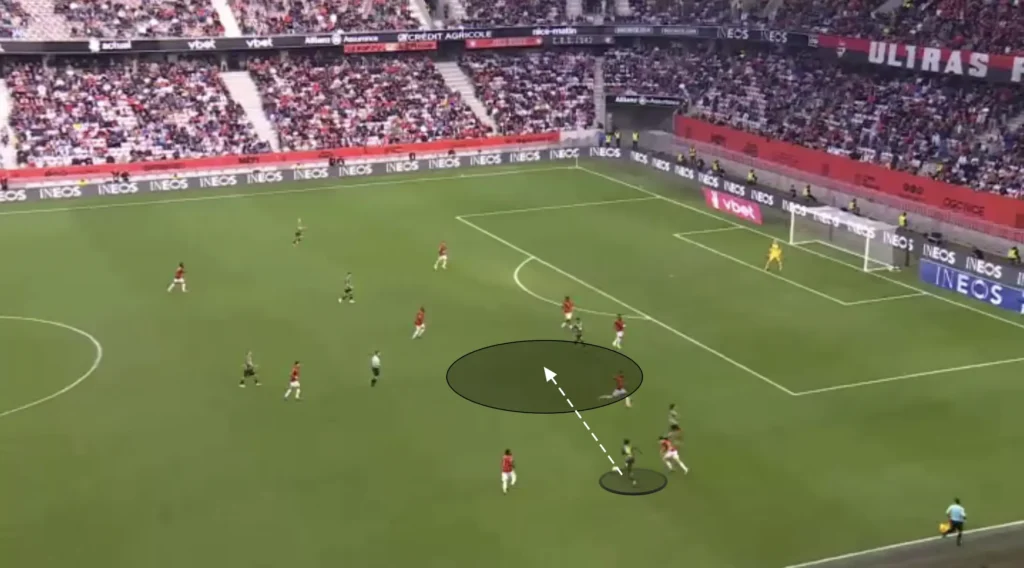
Lille will also exploit this gap between the opposition fullback and center-back with through-balls to well-timed runs from the midfielders. These incisive movements add an extra layer to Lille’s offense, making it harder for defenses to stay organized.
Overlaps
Lille have also used overlaps as a key tactic to create goalscoring opportunities under Bruno Génésio. This involves the fullbacks making forward runs to get around their winger, providing an extra attacking option on the flanks. By doing so, they create a 2v1 situation with the winger against the opposition fullback, which could be used to beat the fullback and create crossing opportunities.
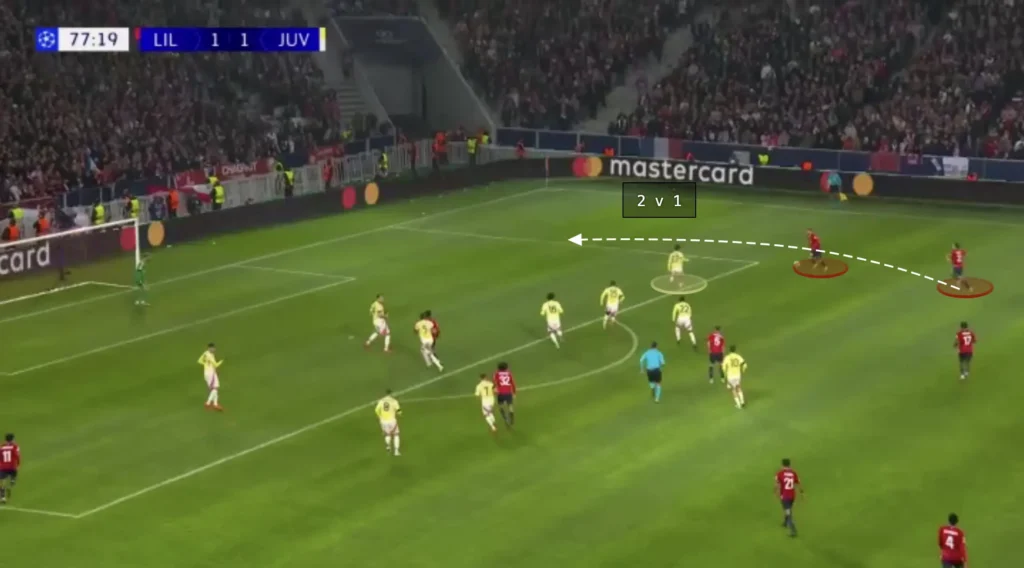
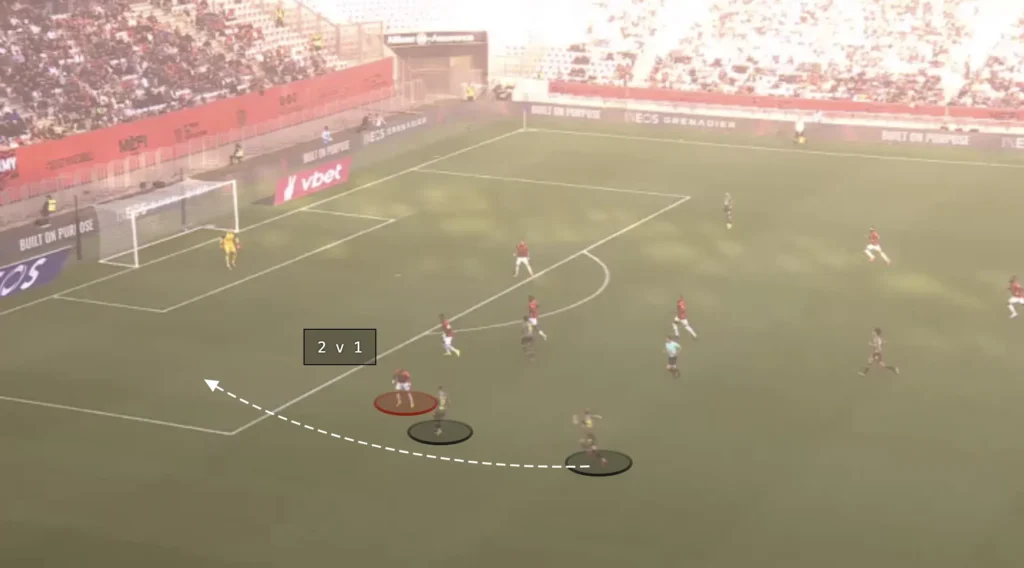
Lille’s wingers often initiate the play by attracting the opposition fullback, leaving space for an overlapping fullback to exploit. The overlap forces the defending fullback to make difficult decisions—either stick with the winger or follow the overlapping fullback. If the opposition fullback drops to cover the overlapping run, the winger could cut inside and take a shot or combine with a midfielder. If the fullback covers the center, the ball can easily be played to the overlapping player, creating a crossing opportunity.
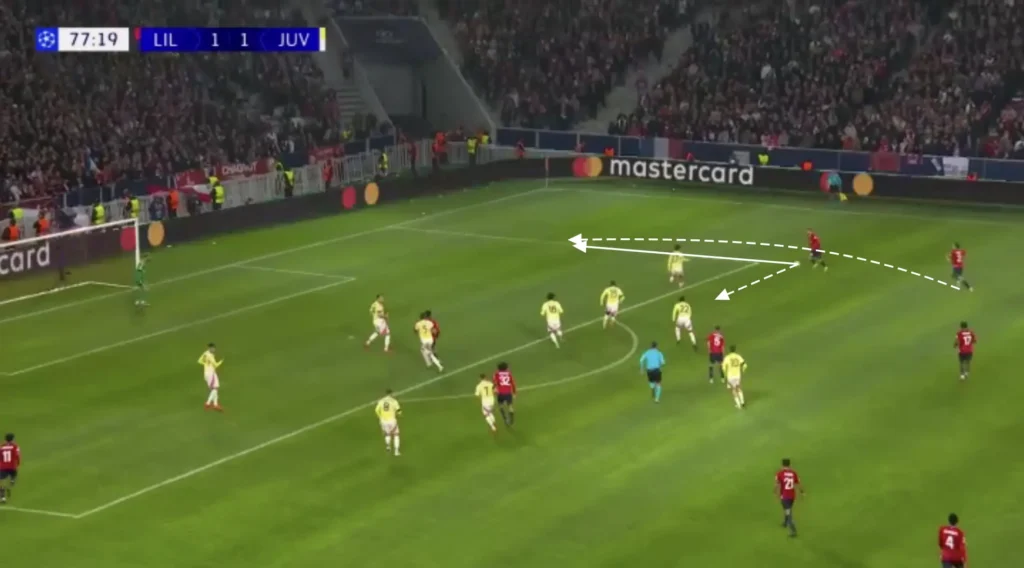
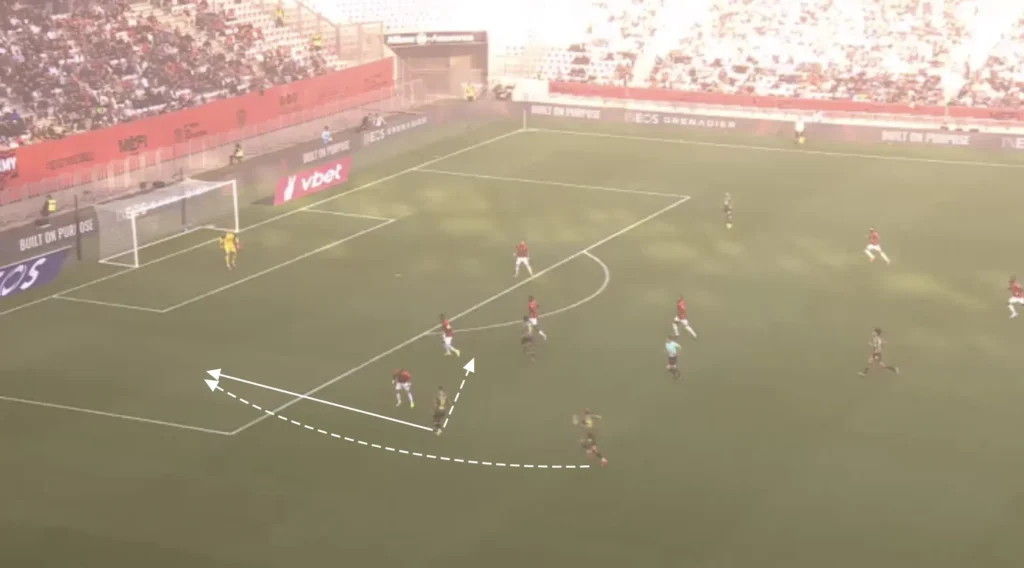
Counterattacks
Lille’s counterattacks are a key element of their tactical approach under Bruno Génésio. The team is highly organized defensively, setting up with a compact, disciplined shape that allows them to quickly transition from defense to attack. Once they win the ball back, the Lille players waste no time moving it forward with precision and urgency.
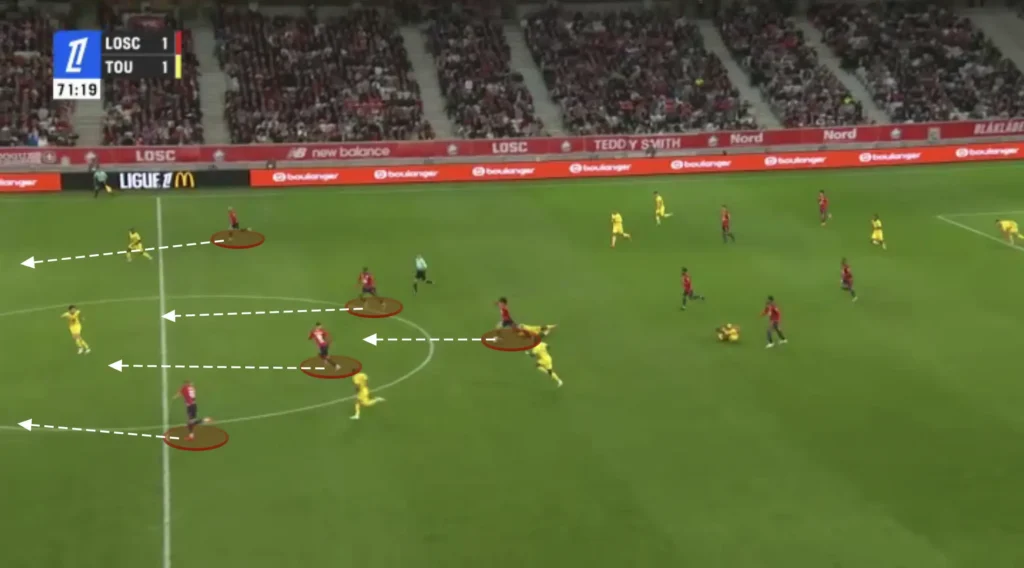
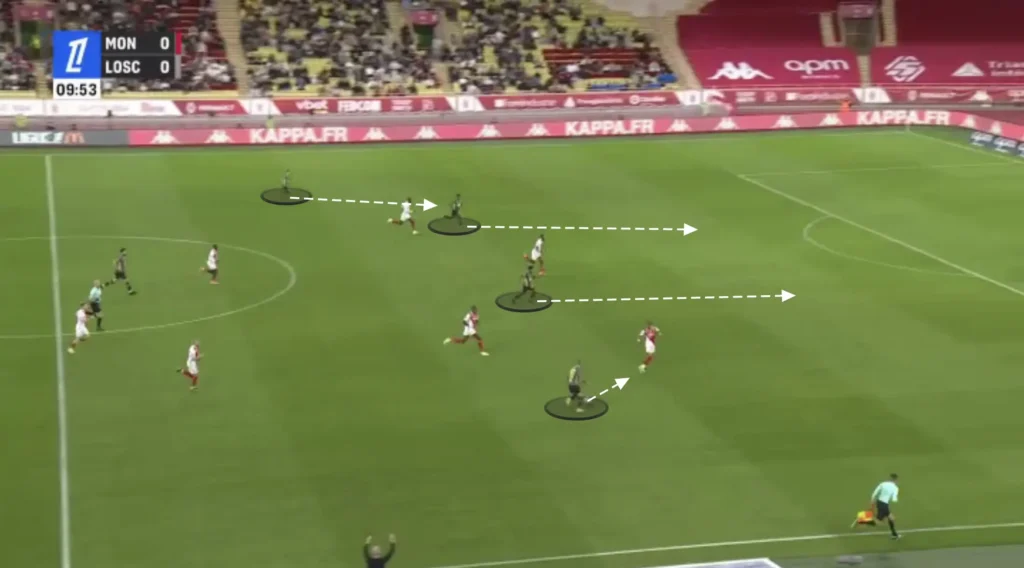
Midfielders play quick, vertical passes to exploit the spaces left by an advancing opposition, often aiming for wide players or strikers who position themselves to break into the attacking third. The Lille players understand when to push forward aggressively and when to hold back, making them highly effective at creating scoring chances out of transitional moments.
Additionally, the Lille players are great at finding open spaces in the counterattacks. Instead of playing the ball straight forward where opposition defenders may still be positioned, they play a diagonal or sideways pass, allowing the team to bypass pressure and shift the play into open areas.
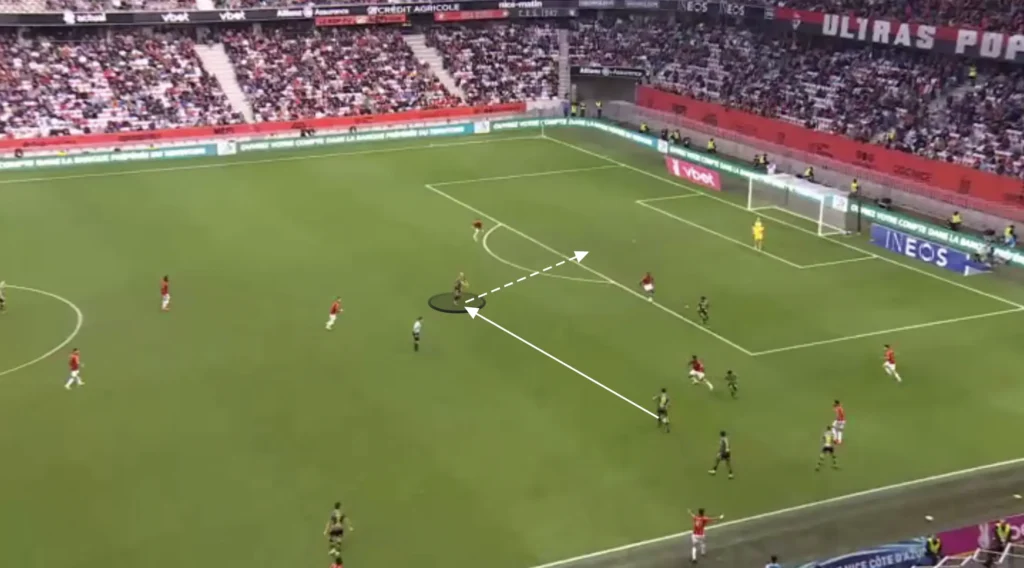
From these areas, the Lille attackers can take the ball forward and quickly get past the opposition to create a goalscoring opportunity.
Defending
Lille’s base formation when defending is the 1-4-4-2 formation.
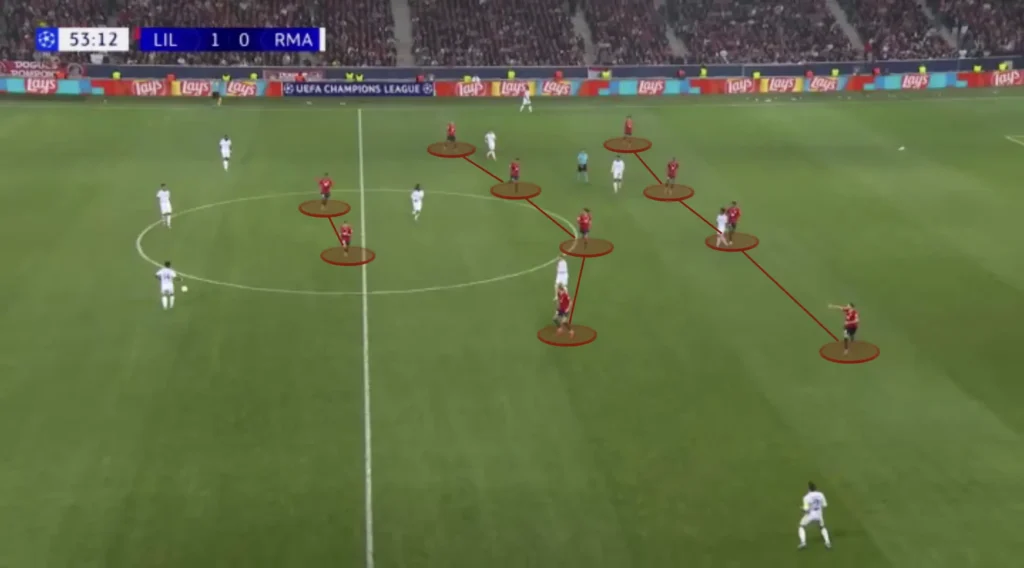
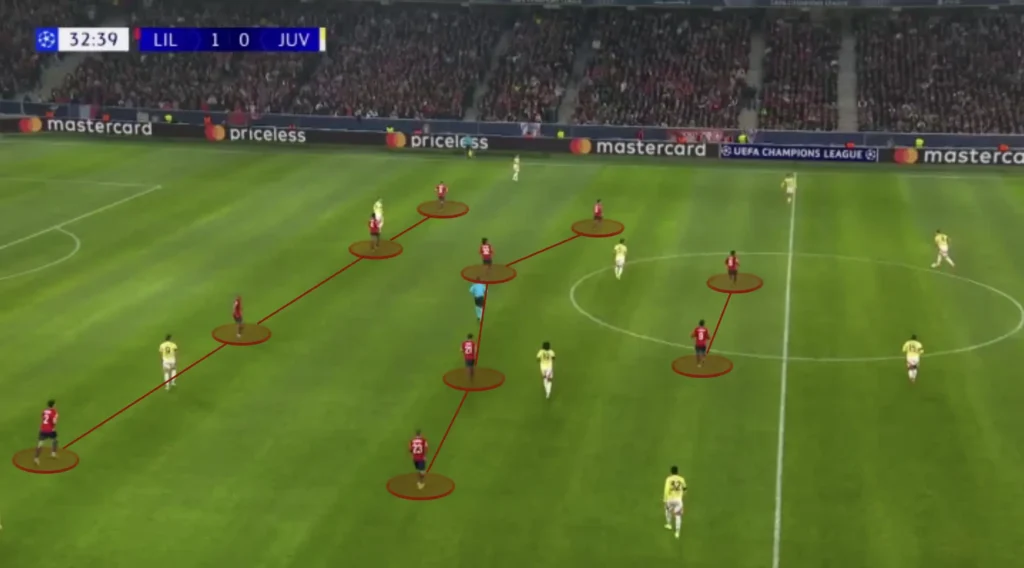
Defending in the 1-4-4-2 formation is all about balance, compactness, and discipline. The team defends in two compact lines of four, with the forwards positioned ahead of the midfield. Génésio wants his team to defend in a compact mid-block, maintaining tight spacing between their lines to limit gaps for the opposition. This disciplined structure forces opponents to play around them, making it difficult to penetrate through the center.
Their standard 1-4-4-2 formation will often become more of a 1-4-2-4 formation when Génésio wants to put more pressure on the opposition.
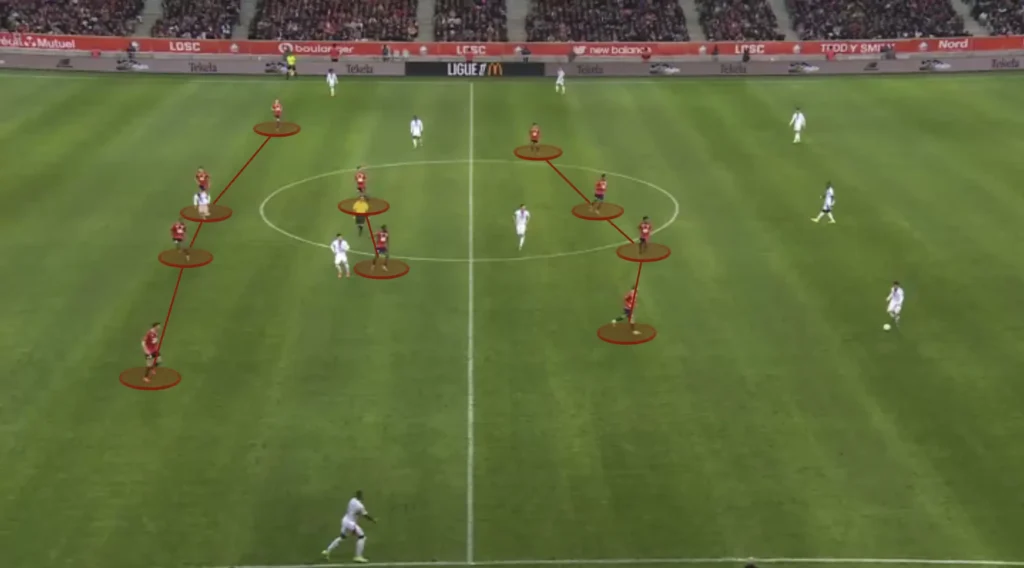
In this defensive system, the wingers will usually press the opposition center-backs while the strikers cover the opposition’s holding midfielders.
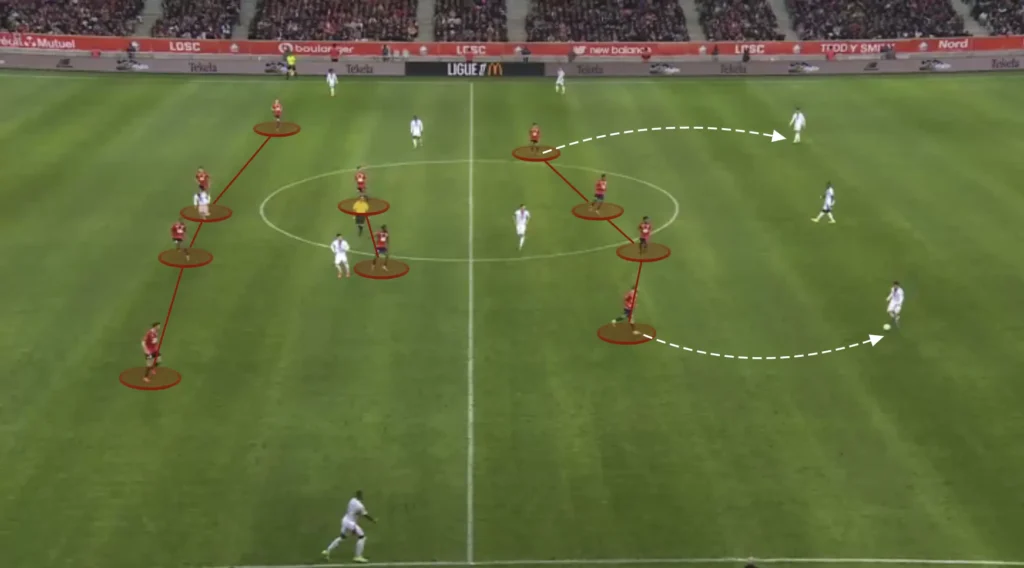
When the wingers press the center-backs, they close the passing lanes to the opposition fullbacks/wingbacks. This forces the opposition center-backs into the middle, where Génésio wants to win the ball with the strikers, who block off all passes into the opposition’s midfielders.
Lille are also known for their tactical flexibility when it comes to their defensive formations. They have, for example, often switched to a 1-4-5-1 or 1-5-2-3 formation when defending.
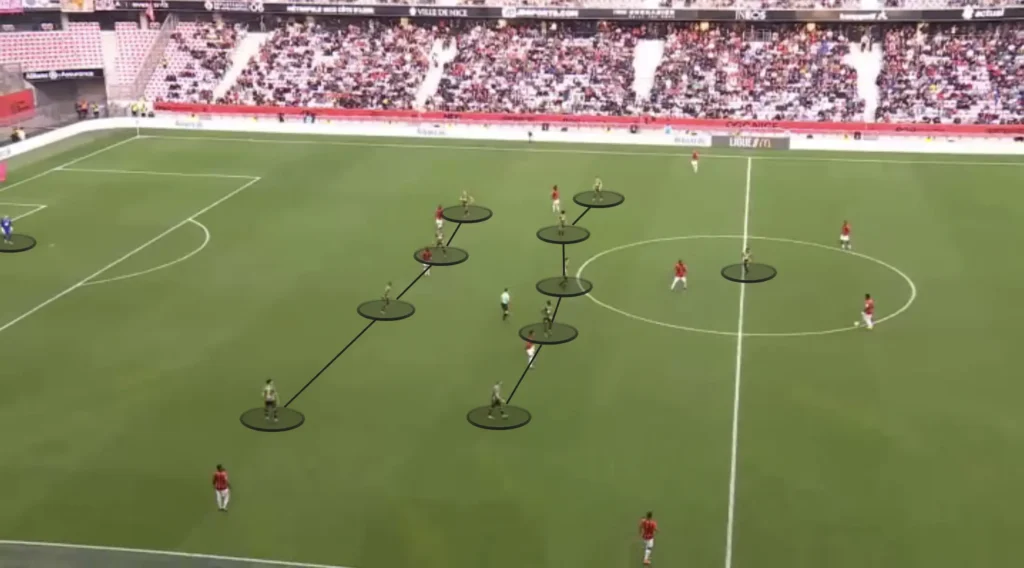
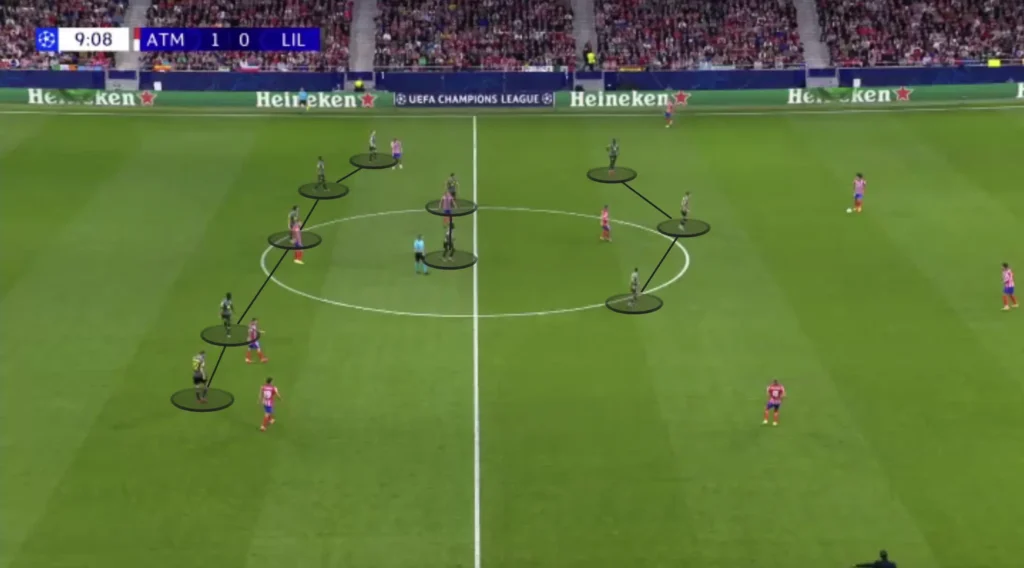
This versatility in their defensive approach allows Lille to adapt to various opponents, giving them an edge in different match scenarios.
High Backline
One tool that helps to be compact is to play with a high backline, making the space to the midfield line as small as possible. Génésio’s players do this and usually try to keep the highest line they can without leaving the space behind them too open. Defending with a high backline involves positioning the defensive line closer to the midfield rather than near the goalkeeper. This tactic compresses the space available for the opposing team to operate, disrupting their build-up play and increasing the chances of winning the ball back quickly.
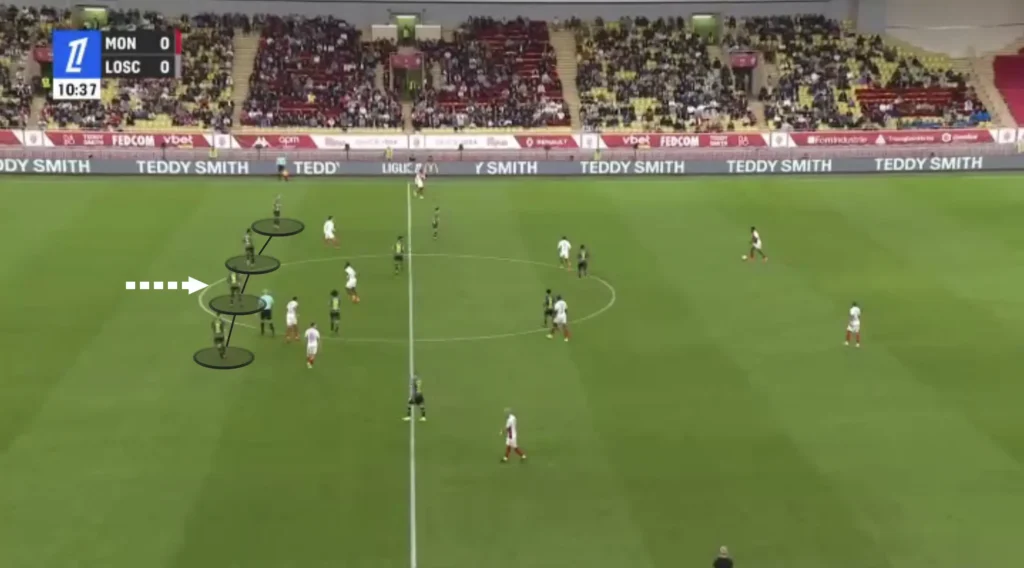
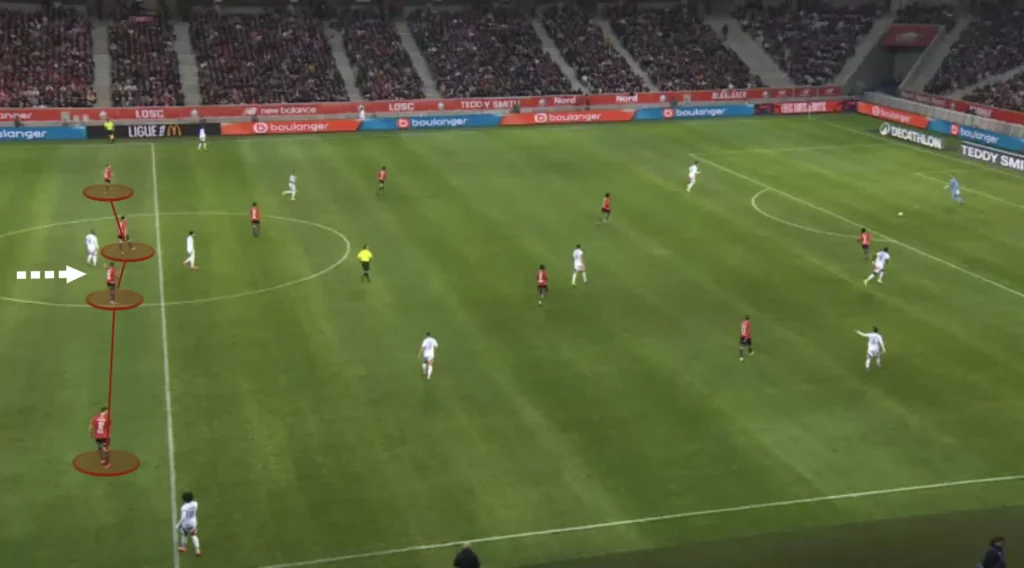
A high backline also allows defenders to support the midfield more effectively, creating numerical superiority in central areas and facilitating quicker transitions from defense to attack. However, it requires defenders with good pace and positional awareness to deal with long balls and prevent opposing attackers from exploiting the space behind. This approach demands constant communication and coordination among the backline to maintain a cohesive and effective defensive structure.
Additionally, everyone must be in the same line when defending with a high backline to maintain an effective offside trap, ensure cohesive coverage, and reduce gaps that attackers can exploit. A well-aligned defensive line makes it easier to catch opposing forwards offside, preventing them from receiving the ball in dangerous positions.
Squeezing the Pitch
To prevent his team from becoming too low when defending, Génésio wants his team to squeeze the pitch. This means constantly pushing the team up as much as possible. Every time the opponent plays a slow, sideways pass or a back pass, Lille’s first line of pressure pushes up, with the rest of the team following to stay compact. When the next pass comes, they push up even more, forcing the opponent back even more.
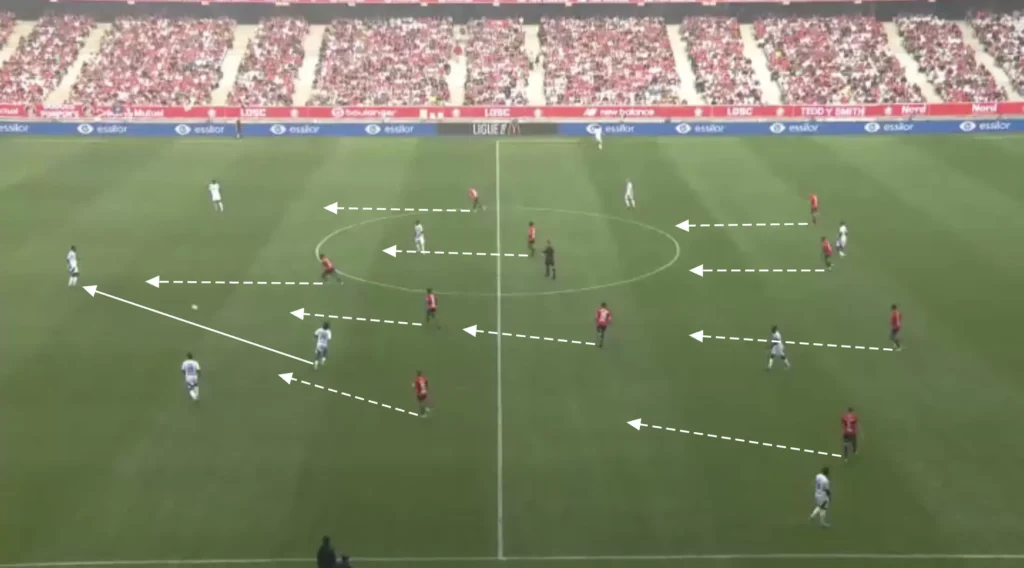
This approach keeps opponents under constant pressure, making it difficult for them to build rhythm or find space between the lines. It also pushes the opponent further away from the Lille goal, making it harder to create chances.
High Press
Lille, under Bruno Génésio, often avoid pressing high up the pitch, preferring to stay compact and organized in a mid-block. However, in some games, they have applied high pressure, especially when they spot opportunities to disrupt the opposition’s build-up in key areas. Their pressing structure will depend on the opposition, but they primarily press in either a man-to-man system or a 1-4-1-2-1-2 formation.
Man-to-Man
Génésio usually wants his team to go man-to-man when pressing the opposition. Each player is assigned a direct opponent to mark tightly, ensuring no easy passing options are available. This intense pressure forces the opposing team into hurried decisions, often resulting in turnovers in dangerous areas. Lille almost use this high press as an attacking threat, scoring many goals from winning the ball high up the pitch.
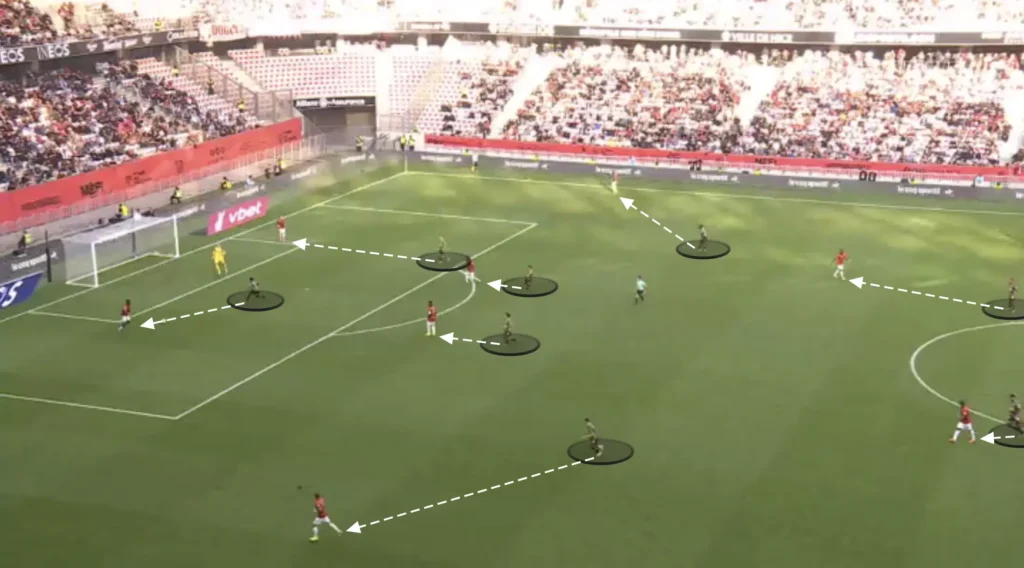
In a man-to-man system, it becomes crucial that the players know when to mark the opponent they are responsible for and when not to. If an opponent, for example, is very far from the ball, the Lille player marking him does not need to be as close to him. He can instead come in and help create numerical superiorities in the center, decreasing the risk of dangerous 1v1 situations.
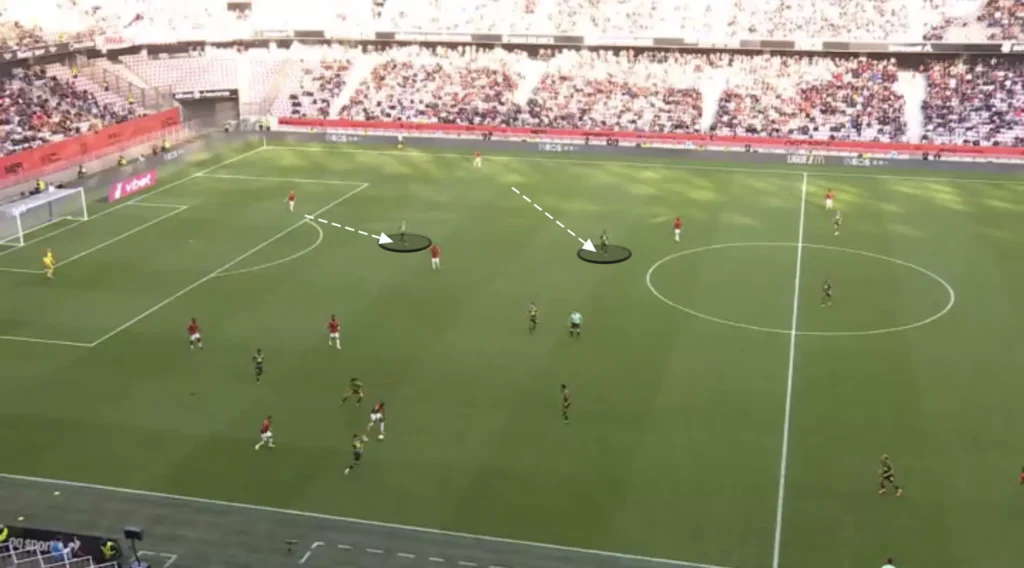
The Lille players will always have an opposition player they are responsible for. However, they will never be closer to them than they need to be. A rule of thumb for the players could be that the closer you are to the ball, the closer you need to be to your opponent. The further away you are from the ball, the further away you can be from your opponent.
1-4-1-2-1-2
Lille have also pressed in a 1-4-1-2-1-2 formation. The focus in this pressing system is to push the opposition out to the side and win the ball there by using the touchline as an “extra” defender.
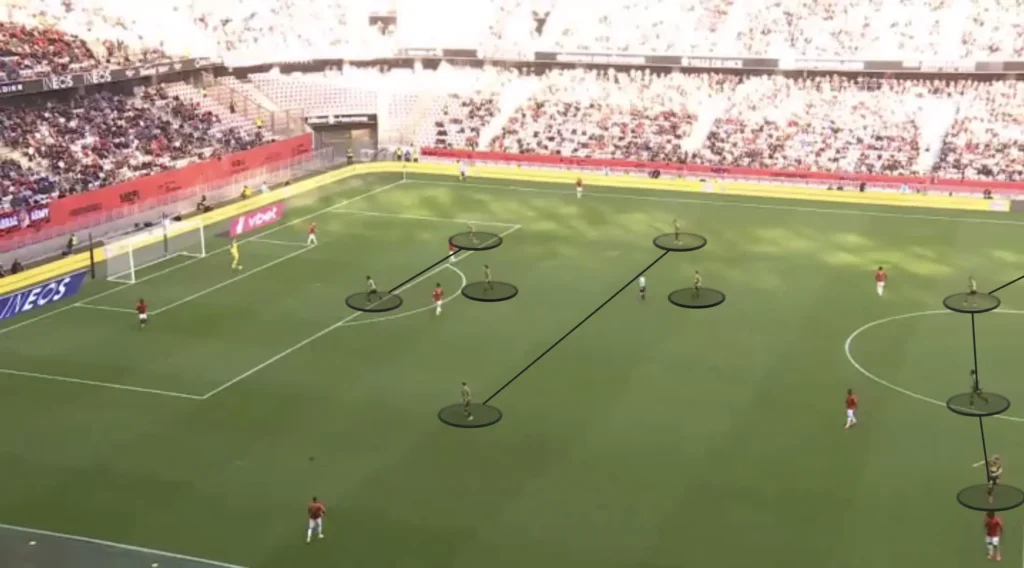
When the play starts, the strikers will try to close off one opposition center-back by making angled pressing runs, forcing the opposition to one side.
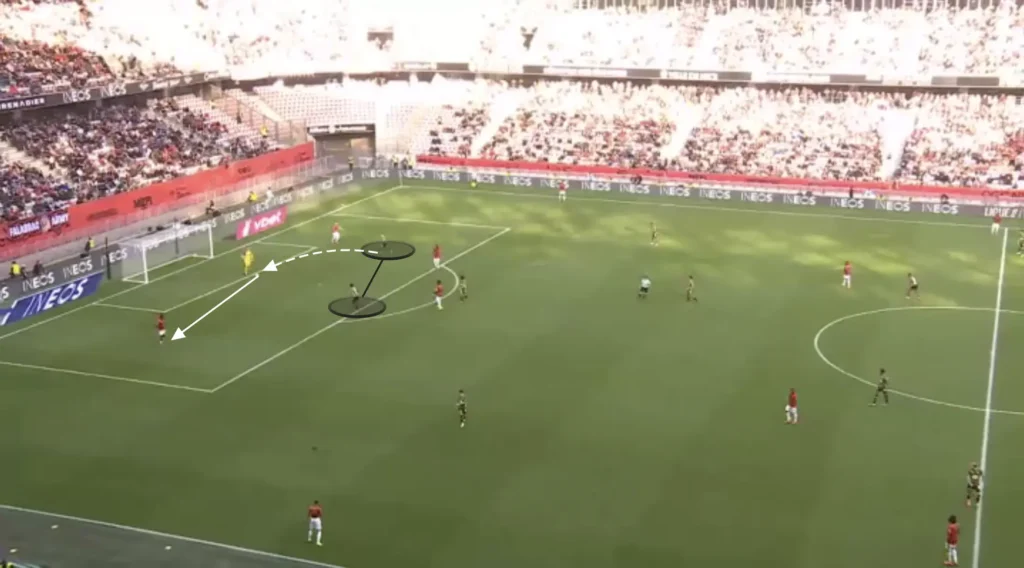
Lille will be aggressive and intensely press to win the ball when it gets played out to one of the opposition fullbacks. The ball-side wide midfielder will push up on the ball-side fullback, with the rest of the midfield shifting across to close down any passing options.
The wide midfielder will press from the inside, closing any passes into the middle. The ball-side striker will try to stop the opposition from switching sides by closing the pass to the ball-side center-back, while the Lille midfielders, who have shifted across, will push up on the opposition midfielders. This gives the opposition fullback very few passing options and often triggers a rushed long ball.
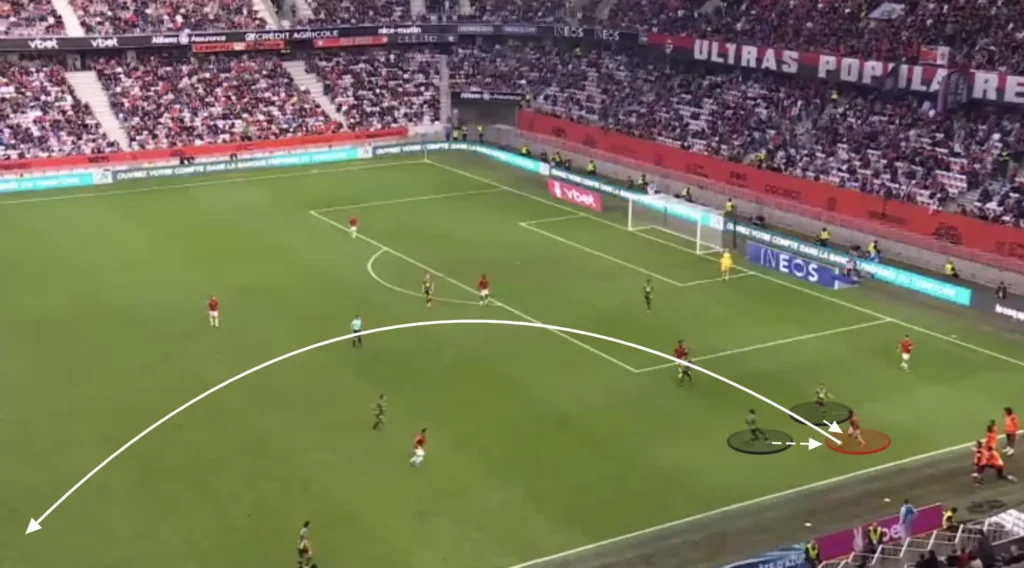
The benefit of this pressing system, compared to the man-to-man system, is that it gives the Lille backline a numerical advantage against the opposition attackers, which means they usually win the long balls.
Final Thoughts
In conclusion, Bruno Génésio’s tactical approach with LOSC Lille highlights a blend of structure, flexibility, and attacking intent. His balanced use of pressing, combined with dynamic build-up play and disciplined defensive structures, has provided Lille with a competitive edge. Génésio’s adaptability in formation and his strategic emphasis on quick transitions showcase his understanding of maximizing Lille’s strengths while managing game demands.
As Lille progresses under Génésio’s leadership, this tactical blueprint reveals a promising foundation. The mix of creative forward play and organized defense positions the team well in Ligue 1 and beyond, making Génésio’s Lille a fascinating squad to follow in the months ahead.
